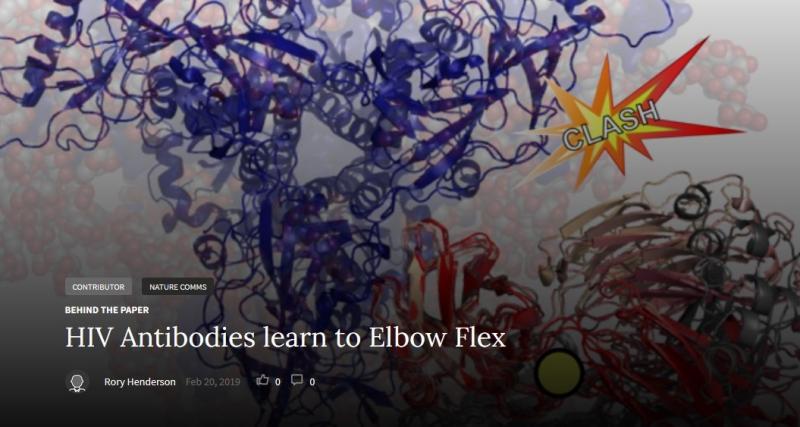
Behind The Paper blog post by DHVI post-doc, Rory Henderson, for the Nature Research Micrbiology Community. In this post, Dr. Henderson describes the thinking behind his paper, “Selection of immunoglobulin elbow region mutations impacts interdomain conformational flexibility in HIV-1 broadly neutralizing antibodies,” and how the research progressed over time.
Mounting an effective immune response to HIV-1 infection by the immune system presents a daunting challenge. The HIV-1 envelope protein, termed Env, represents the sole target for antibody mediated neutralization by the immune system. Development of a broadly neutralizing response to the Env protein spike to effectively attack the HIV-1 Env requires identifying weaknesses on the Env surface that allow consistent contact across a landscape, rendered essentially featureless by the interminable introduction of mutations at the sites with broadly neutralizing potential. This is further complicated by the presence of a dense, shifting glycan shield rendering the Env nearly impenetrable at sites critical for broad neutralization. Yet 50% of HIV-1 infected individuals ultimately generate a degree of heterologous neutralization breadth after years of infection. A key feature of the HIV bnAbs is the high frequency of mutations (>40% substitutions), including rare events like “indels” (insertion/deletion). In addition to acquiring mutations in and around the binding interface, HIV bnAbs have a high frequency of mutations in the FWR region that play critical roles in maintaining antibody structural stability and variable loop flexibility.
In our paper, with a mind to determine how bnAbs unlock the way toward broad neutralization, we examined the physical properties of successful HIV-1 broadly neutralizing antibodies to determine which mutations provide a gain of fitness to the fledgling antibodies in the lineage. By examining the changes in the thermal stability of the antibodies, we discovered that bnAbs consistently display a drop in the Tm, the temperature at which half of the protein has denatured, in the antigen binding fragment, termed the Fab. A drop in Tmis often an indication that somewhere in the structure, a mutation has introduced flexibility. The remarkable consistency with which the bnAbs displayed this temperature drop suggested the Env was presenting a difficult challenge to which the antibodies must adapt. But when during the bnAb maturation must this challenge be met? To answer this question, we next turned to two available bnAb lineages with differing epitope specificities. We found that in both lineages, a dramatic reduction in Tmoccurred early on during development. Strikingly, this reduction was retained throughout bnAb development suggesting that the adaptation was essential for acquisition of neutralization breadth. Digging more deeply into the source of this change, we examined mutations in the early intermediates of one bnAb to determine how the reduced Tmwas introduced. We found that a single mutation in a second point of domain flexibility distinct from the well-known antibody hinge, termed the Fab elbow joint, resulted in a change in thermal melting temperature. Examining the effect of this mutation via molecular dynamics simulation, a theoretical method which examines the time dependent motions of atoms through space, we found that the elbow hinge displayed a dramatic shift from its original position, allowing it to penetrate a portion of the Env glycan shield. This elbow shift was further associated with a shift in the antigen contact region of the Fab. Observing this remarkable change in the antibody associated with the m reduction and increases in heterologous Env binding, we examined the extent to which all bnAb acquire similar mutations. We found that all antibodies in the same epitope class acquire multiple mutations in the elbow region and that the majority of bnAbs from all epitope classes acquire them. Extending the investigation to other bnAb lineages, we consistently observed these mutations occurring early in bnAb maturation at the initial acquisition of neutralization breath and, further, that reversion of these mutations can hinder breadth.
Together, the findings in our paper indicate that developing neutralization breath is far more than simply choosing the right contact points for the antibody. Rather, the antibody must develop an ability to adapt to changing steric circumstances through a myriad of challenging movements to acquire the ability to adapt toward interacting with and neutralizing the extreme diversity presented by the HIV-1 Env. Though certainly not the only roadblock to successful induction of broad neutralization viaan HIV-1 vaccine, the findings in this paper demonstrate a key barrier to teaching the immune system how to attack the HIV-1 Env is the introduction of spatial adaptability to the antibody Fab allowing it to bind avidly to the seemingly insurmountable wall of HIV-1 diversity.
Click here to read the "Selection of immunoglobulin elbow region mutations impacts interdomain conformational flexibility in HIV-1 broadly neutralizing antibodies".